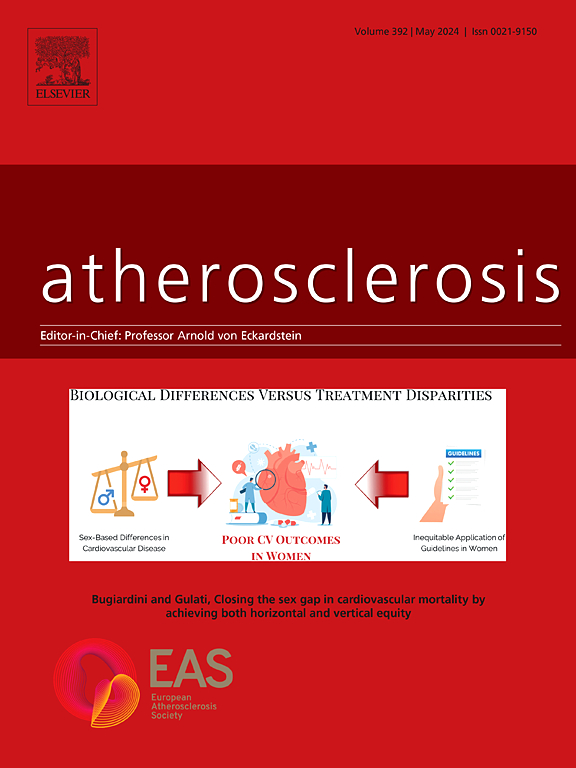Advancing atherosclerosis research: The Power of lipid imaging with MALDI-MSI
IF 4.9
2区 医学
Q1 CARDIAC & CARDIOVASCULAR SYSTEMS
引用次数: 0
Abstract
Atherosclerosis is a chronic inflammatory disease that is one of the leading causes of mortality globally. It is characterized by the formation of atheromatous plaques in the intima layer of larger arteries. The (fibro-)fatty plaques usually develop asymptomatically within the vessel until a serious event such as myocardial infarction or stroke occurs. Lipids play a pivotal role in disease progression, but while the causal role of cholesterol is beyond doubt, the distribution of numerous other lipids within the heterogeneous layers of atherosclerotic plaques, and their biological function remain unclear. A deeper understanding of the pathophysiological progression of the disease for prognostics, diagnostics, treatment, and prevention is of great need. Mass spectrometry imaging (MSI), in particular with matrix-assisted laser desorption/ionization (MALDI) offers an unprecedented untargeted characterization of the physiological microenvironment, unraveling the spatial distribution of numerous biochemical compounds. MALDI-MSI offers an advantageous balance of sample preparation, chemical sensitivity, and spatial resolution, and thus has been established as a key technology in modern biomedical analysis. This review focuses on the analysis of lipids in atherosclerotic lesions with MALDI-MSI, for which the past years showed major developments in the spatial characterization of lipids and their interaction within atherosclerotic plaques. We will cover main contributions with a focus on the recent decade, elaborate possibilities, limitations, main findings, and recent developments from sample handling to instrumentation, and estimate current challenges and potentials of MALDI-MSI with respect to a clinical application.

推进动脉粥样硬化研究:MALDI-MSI脂质成像的力量。
动脉粥样硬化是一种慢性炎症性疾病,是全球死亡的主要原因之一。它的特点是在大动脉内膜形成粥样斑块。(纤维)脂肪斑块通常在血管内无症状地形成,直到心肌梗死或中风等严重事件发生。脂质在疾病进展中起着关键作用,尽管胆固醇的因果作用毋庸置疑,但在动脉粥样硬化斑块的异质性层中,许多其他脂质的分布及其生物学功能仍不清楚。更深入地了解疾病的病理生理进展,以进行预后、诊断、治疗和预防是非常必要的。质谱成像(MSI),特别是基质辅助激光解吸/电离(MALDI),提供了前所未有的生理微环境的非靶向表征,揭示了许多生化化合物的空间分布。MALDI-MSI提供了样品制备、化学灵敏度和空间分辨率的有利平衡,因此已成为现代生物医学分析的关键技术。这篇综述的重点是用MALDI-MSI分析动脉粥样硬化病变中的脂质,过去几年在脂质空间表征及其在动脉粥样硬化斑块中的相互作用方面取得了重大进展。我们将重点介绍近十年来的主要贡献,详细阐述从样品处理到仪器的可能性、局限性、主要发现和最新发展,并估计MALDI-MSI在临床应用方面的当前挑战和潜力。
本文章由计算机程序翻译,如有差异,请以英文原文为准。
求助全文
约1分钟内获得全文
求助全文
来源期刊

Atherosclerosis
医学-外周血管病
CiteScore
9.80
自引率
3.80%
发文量
1269
审稿时长
36 days
期刊介绍:
Atherosclerosis has an open access mirror journal Atherosclerosis: X, sharing the same aims and scope, editorial team, submission system and rigorous peer review.
Atherosclerosis brings together, from all sources, papers concerned with investigation on atherosclerosis, its risk factors and clinical manifestations. Atherosclerosis covers basic and translational, clinical and population research approaches to arterial and vascular biology and disease, as well as their risk factors including: disturbances of lipid and lipoprotein metabolism, diabetes and hypertension, thrombosis, and inflammation. The Editors are interested in original or review papers dealing with the pathogenesis, environmental, genetic and epigenetic basis, diagnosis or treatment of atherosclerosis and related diseases as well as their risk factors.
 求助内容:
求助内容: 应助结果提醒方式:
应助结果提醒方式:


